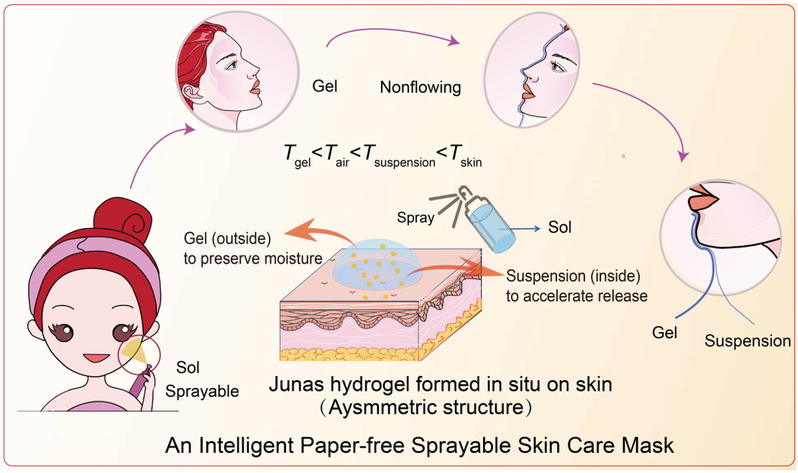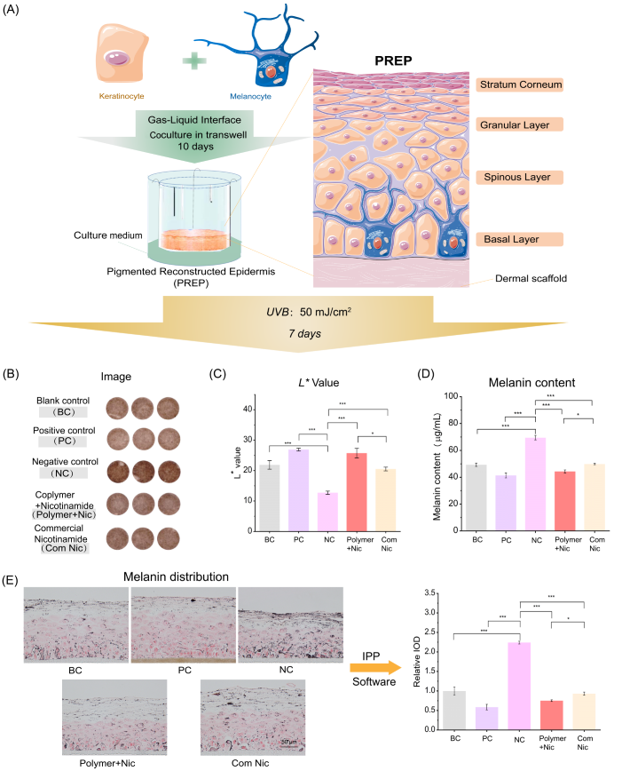 +565 975 658
+565 975 658
 info@premiumcoding.com
info@premiumcoding.com
 Monday - Friday, 8.00 - 20.00
Monday - Friday, 8.00 - 20.00
Medical devices and pharmaceutics are based upon available raw materials. It is important for any material to be approved by US Food and Drug Administration (FDA) or other bureaus for the first time. While poly(ethylene glycol) (PEG) and poly(lactide-co-glycolide) (PLGA) have been applied clinically, none of their block copolymers has been approved as a medical material. Ding’s group has been devoted to research and development (R& D) of thermogels composed of PLGA-PEG-PLGA block copolymer for more than a score of years, and the present report concerns their recent effort to extend this kind of intelligent materials into cosmetics and aesthetic medicine. In particular the first-in-human study of this new polymer on skin might have impact to the potential translation of the underlying new biodegradable copolymer.
With the improvement of living standards, skin problems have attracted more and more attention, and skin care products have been an indispensable part of modern lives. Traditional skin masks have many limitations. Taking facial masks as an example, a piece of paper is needed to support the aqueous essences. Using a paper mask on the face is not environmentally friendly, and the mask paper cannot precisely fit the individual facial structure. So it is desirable to invent a paper-free gel mask. However, normal gel masks do not allow for rapid release of a substance. Even if using a gel as a sleep mask allows the substance to be released and absorbed for 7–8 h, covering the skin surface with a gel film for a long time is not optimal for the respiration and metabolism of skin cells. Therefore, how to quickly release substances while keeping moisture is a key to an advanced paper-free mask.
Recently, the research group led by Prof. Jiandong Ding at Fudan University designed an intelligent sprayable skin care mask using a thermogel with sol-gel-suspension phase transitions upon heating. The thermogel is composed of an aqueous system of a biodegradable amphiphilic block copolymer composed of PEG and polyester. The amphiphilic block copolymer chains in water form micelles with hydrophilic PEG segments as the corona and hydrophobic PLGA segments as the core. While it is common for amphiphiles to form micelles in water, it is surprising for a surfactant to form a hydrogel upon heating. The gelation is caused by percolation of “semi-bald micelles” as revealed by Prof. Jiandong DING. The aqueous system is at a solution state at low temperatures and can be mixed with active substances and sprayed. When sprayed to the skin, the temperature difference of between the air and skin can be used to form an asymmetric Janus structure of a hydrogel skin care mask in situ. Specifically, if the two phase-transition temperatures meet the requirements of Tgel < Tair < Tsuspension < Tskin , the side that contacts the air is Gel, and the side that contacts the skin is Suspension, which constitutes an asymmetric hydrogel or a Janus hydrogel, as shown in Figure 1.

Figure 1. Schematic presentation of an intelligent paper-free sprayable skin mask. Cartoon of the procedure: after spraying the solution onto the skin of a person, the applied solution turns into an asymmetric intelligent mask on the skin because of the temperature difference between the skin and the air, forming a suspension inside and a gel outside. In such an intelligent sprayable skin mask, the condition of Tgel < Tair < Tsuspension < Tskin leads to the dual effects that the physical hydrogel layer on the outside preserves moisture and the suspension layer on the inside promotes the release of active substances. Here, Tgel denotes sol–gel transition temperature, and Tair, the air temperature, Tsuspension, gel-suspension transition temperature, Tskin, skin surface temperature
A commercialized whitening agent—nicotinamide was selected as an active substance to be encapsulated in the thermogel, and the cumulative release curves of nicotinamide at different temperatures were fitted by Higuchi equation (Figure 2). The release in the solution state at low temperatures was rapid compared to in the gel and suspension states at high temperatures, and the release rate in the suspension state was much faster than that in the gel state, which proves the expected intelligent release.

Figure 2. In vitro release profiles of nicotinamide from hydrogels at the indicated temperatures. Cumulative release curves fitted by Higuchi equation of nicotinamide (5 wt%) released from a non-thermosensitive gel (10 wt% PVA) and a thermogel (10 wt% copolymer) at 10, 25, 30, and 35 oC. While the k values corresponding to the PVA system increased slightly as the temperature rose because of no phase transition, those of the thermogel system decreased sharply and then increased significantly because of sol–gel-suspension transitions.
The team employed the 3D pigmented reconstructed epidermis model (3D-PREP) with epidermal structure by co-culture of human epidermal keratinocytes and melanocytes at the gas-liquid interface to verify the whitening effect, which was found better than a commercial nicotinamide mask (Figure 3).

Figure 3.The 3D pigmented reconstructed epidermis (PREP) model to examine the whitening efficacy in vitro. A) The preparation process of 3D PREP tissue and B–D) the results with images captured by B) scanner, C) L* values, D) melanin contents, representative histologic sections with Masson Fontana silver staining (E left) and the integrated optical density (IOD) of the black part (melanin content) calculated from the images by Image-Pro Plus software and the normalization of each group over the blank control (E right) of PREP treated for 7 days. (n = 3; “***”: p < 0.001; “*”: p < 0.05; blank control, no treatment; positive control, with UVB stimulus and kojic acid treatment; negative control, with UVB stimulus and no treatment; UVB = 50 mJ cm-2; “Com Nic”, nicotinamide-containing liquid squeezed from a commercialized facial mask.)
Finally, after being approved by the ethical committee for human trials of Fudan University, volunteers were recruited to participate in the first-in-human study. The results confirmed the safety and efficacy of the synthetic copolymer and the corresponding formulation on skin (Figure 4).

Figure 4. The first-in-human study of thermogels on skin. A) The process of the human study; B) the changes of L*, a* and b* values on 2 and 4 weeks; the dashed lines are for guidance of reading. C) The score of self-assessment on 2 weeks and 4 weeks. D) Representative images for assessment of hypopigmentation before and after using copolymer + nicotinamide (left hand) and normal saline (right hand) for 4 weeks. Error bars represent the standard deviation (n = 30). “***” represents a significant difference with p < 0.001.
Janus structures have been investigated in the fields of polymer science, soft matter and self-assembly, and even some Janus hydrogels have been reported with potential as biomedical materials etc. The present work distinguishes itself as the spontaneous formation of a Janus structure after spraying a solution onto skin. The copolymer solution presents excellent sprayable performance, and a nonflowing state was achieved after being sprayed onto the skin. This makes such a material more convenient to use, in line with the fast pace of modern life. Based on a series of studies of molecular engineering of polymers, Ding’s group has found that the copolymer with appropriate molecular weight and block ratio can lead to sprayability and thermogellability, which can even remain after loading nicotinamide. These properties can potentially be used for sprayable masks, and also pharmaceutics, delivery of cells and tissue engineering. For example, extension of this principle into the treatment of burns and other skin surface medication is highly promising.
Ding’s group has investigated thermogel for more than 20 years, and has recently endeavored to the translation of thermogel. This work tried thermogel as cosmetics and tested on human body for the first time. Once the first thermogel product is successfully applied to human, it will become a breakthrough in this field and drive thermogel to be gradually applied to human in other aspects such as sustained release of anti-tumor and anti-diabetic drugs.
The study was published in Advanced Healthcare Materials with Ms. Caiyun CAI, a Ph.D. student as the first author and her supervisor Prof. Jiandong DING, director of State Key Laboratory of Molecular Engineering of Polymers, distinguished professor at Fudan University as the corresponding author. See: Caiyun Cai, Jingyu Tang, Yi Zhang, Weihan Rao, Dinglingge Cao, Wen Guo, Lin Yu, and Jiandong Ding*. Intelligent Paper-Free Sprayable Skin Mask Based on an In Situ Formed Janus Hydrogel of an Environmentally Friendly Polymer. Adv. Healthcare Mater. 2022, 2102654 (pages 1-16).
Article link: https://doi.org/10.1002/adhm.202102654
Get to know us better now!

Wechat:FDUMMers
Search!
Search across our website
Revenant @ 2018 by fudan | All Rights Reserved
Powered by Weicheng

